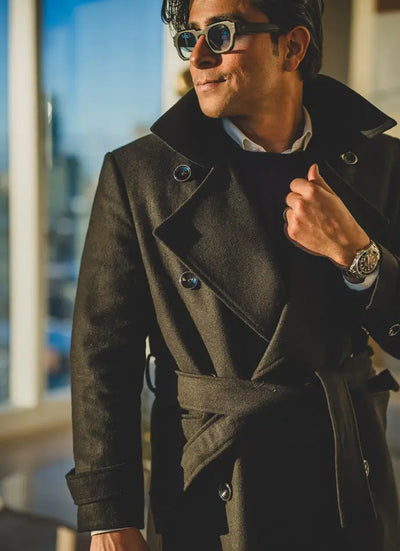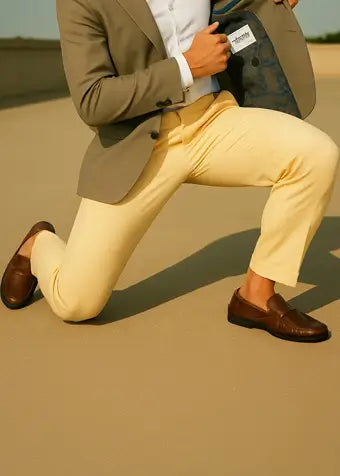
White Tie vs. Black Tie
Contents
- White Tie Attire: What You Need To Know For Formal Events
- Black Tie Attire: Key Elements For A Perfect Look
- When Should You Wear White Tie Vs. Black Tie?
- How To Style A White Tie Outfit
- How To Style A Black Tie Outfit
- Common Mistakes To Avoid In Formal Dress Codes
- Final Thoughts
- Frequently Asked Questions About White Tie Vs. Black Tie
Key Takeaways:
- White Tie vs. Black Tie: Understanding the differences between these formal dress codes ensures you always wear the right attire for prestigious events and upscale parties.
- Key White Tie Elements: Tailcoats, wingtip collars, white waistcoats, and accessories like white gloves define the luxurious formality of a white tie.
- Black Tie Essentials: To nail the black tie dress code, you must have a well-tailored tuxedo, proper tuxedo shirt, and classic black silk bow tie.
You get an invite that says White Tie or Black Tie, and suddenly your confidence wavers. Do you go full tux? Are tails involved? What about your shoes, or the shirt, or the bow tie?
At Sartoro, we get it. We're rooted in modern tailoring that actually makes sense for how people dress today—laid back, elevated, and always intentional. Whether you're suiting up for a wedding, gala, or high-profile dinner, we believe dressing well shouldn't feel exclusive or uptight. It should feel like you—at your best.
This guide breaks down the essentials of White Tie vs. Black Tie—what to wear when it matters and how to own the look confidently (no guesswork required).
White Tie Attire: What You Need To Know For Formal Events
White tie attire represents the pinnacle of formal dressing, reserved for the most prestigious events such as state dinners, galas, and royal affairs. Understanding the critical components of white tie is essential for those aiming to present themselves with sophistication and elegance.
- Tailcoat and Trousers: The cornerstone of white tie attire is the black tailcoat, which differs significantly from a standard suit jacket. It features a waist-length cut in the front with elongated tails in the back. This ensemble epitomizes traditional elegance, paired with matching high-waisted black trousers featuring a satin stripe down the side.
- Shirt and Waistcoat: A crisp white dress shirt with a wingtip collar is mandatory, complementing the tailcoat's decorum. This is traditionally worn with a white piqué waistcoat, adding layers of refined contrast. The waistcoat should not extend below the tailcoat when standing, maintaining a seamless silhouette.
- Accessories and Details: A white bowtie, distinctively constructed from pique fabric to match the waistcoat, is pivotal in distinguishing the white tie dress code. Enhancing this sophisticated look with formal black patent leather shoes and subtle yet luxurious accessories, such as cufflinks or a pocket watch, completes the attire.
Black Tie Attire: Key Elements For A Perfect Look
Black tie events are formal, but they’re not rigid. Think elevated, not stiff. The goal is to look sharp without looking like you're trying too hard. Here's what makes up a proper black tie look and how to get it right without the guesswork.
Tuxedo Jacket
A black or midnight navy tuxedo jacket with satin or grosgrain lapels is standard. Peak lapel or shawl collar—both work. Fit is everything here. A custom-made tuxedo from Sartoro ensures clean lines and a silhouette that works with your build, not against it.
Matching Trousers
Trousers should match the jacket in both fabric and color, with a satin stripe running down the side. Skip the belt loops—side adjusters or suspenders keep the look tailored and clean.
Tuxedo Shirt
A proper tuxedo shirt is non-negotiable. Look for a white shirt with a pleated or bib front, French cuffs, and a spread or wing collar. Sartoro’s custom tuxedo shirts offer a refined fit and detail that sets the tone for the look.
Bow Tie
A black silk or satin bow tie is traditional. Pre-tied is fine in a pinch, but a hand-tied bow is the way to go if you want polish.
When Should You Wear White Tie Vs. Black Tie?
Knowing the difference between white tie and black tie isn't just about the clothes—it’s about understanding the context. Each dress code signals a certain formality, and wearing the wrong outfit can leave you feeling out of place. Here’s when to wear each, so you always show up looking sharp and appropriately dressed.
White Tie Events
White tie is reserved for the most formal occasions. If it’s on the invite, expect a high-profile, traditional event with strict dress expectations. You’ll typically wear white tie to:
- State dinners and royal galas
- High-society balls
- Formal operas or classical music performances (rare, but possible)
- Select diplomatic or academic ceremonies
These are events where tradition reigns, and every detail—from tails to white gloves—is part of the code.
Black Tie Events
Black tie is formal, but more common and flexible than white tie. It’s polished, elevated, and expected at most upscale evening events. You’ll typically wear black tie to:
- Formal weddings
- Evening galas and charity events
- Award shows or red-carpet events
- Formal dinners and private parties
- High-end holiday parties
When the invitation says “black tie optional,” a tuxedo is still preferred, but a well-tailored dark suit can be acceptable—just make sure everything else (shirt, tie, shoes) follows the black tie spirit.
How To Style A White Tie Outfit
When entering the world of white tie attire, every element of your ensemble should reflect the pinnacle of elegance and sophistication. Unlike their counterpart, black tie, white tie outfits require meticulous attention to detail and adherence to tradition.
The Tailcoat
The centerpiece of your white tie ensemble is the tailcoat. Unlike a standard tuxedo jacket, a tailcoat is waist-length at the front with long tails at the back. When designing your tailcoat with Sartoro, select classic black from our premium fabric collection to maintain traditional elegance. Remember, the tailcoat is meant to be worn open, enhancing its regal aesthetic.
The White Waistcoat
Underneath your tailcoat, the white waistcoat provides a distinguished layering element. Ensure it is properly fitted, which you can easily achieve through Sartoro’s AI-powered Digital Tailor. Opt for a waistcoat cut low on the chest for a polished appearance to frame your dress shirt and bow tie perfectly.
The Wingtip Collar Shirt
The shirt is as critical as the tailcoat in a white tie dress code. Choose a crisp, white shirt with a wingtip collar that stands sharply against the black and white attire. Sartoro offers customization options that allow you to design a shirt that reflects traditional elements far removed from your typical office wear, ensuring it stands out in a formal setting.
The Bow Tie
The crowning element of your white tie look is the bow tie. It should be white, perfectly complementing your waistcoat. Sartoro's selection of accessories ensures you’ll find a bow tie made with premium materials, adding a touch of luxury to your ensemble. Focus on achieving a neatly styled bow for a flawless finish.
Formal Trousers
Your trousers should match the fabric of your tailcoat, typically black, and feature a satin stripe along the leg seams. Sartoro’s bespoke offering lets you ditch the generic fit and design trousers that sit perfectly on your frame, ensuring comfort without sacrificing elegance.
Accessories
Don’t overlook the subtle accessories that elevate your ensemble. Dress studs, cufflinks, and white gloves are traditional embellishments for a white-tie event. Opt for high-quality pieces that reflect your personality—after all, attention to detail sets apart a refined white tie outfit from merely good to exceptional.
How To Style A Black Tie Outfit
Black tie isn't about playing dress-up—it's about showing up with intention. The goal is to look polished without looking like you're wearing a costume. Sartoro takes the guesswork out of the equation with modern, custom options that work with your body and style. Here’s how to assemble a black tie outfit that feels effortless, not outdated.
Choose A Classic Tuxedo
Go for a single-breasted black or midnight navy tuxedo with satin lapels. Sartoro’s custom tuxedos ensure a sharp, contoured fit without boxy or off-the-rack vibes. Lapel choice:
- Shawl collar for a smoother, more relaxed look
- Peak lapel for a more structured, traditional style
Match The Trousers
Your trousers should match the jacket fabric, with a satin stripe running down the side. No belt loops—use side tabs or suspenders to keep everything clean.
Wear A Proper Tuxedo Shirt
Not just any white shirt. A tuxedo shirt sets the tone for the whole outfit. Look for:
- A pleated or pique front
- French cuffs (you’ll need cufflinks)
- A spread or wingtip collar
Sartoro’s tuxedo shirts are custom-made for a streamlined fit—no excess fabric, no pulling.
Add The Bow Tie
A black silk or satin bow tie is essential. If you're comfortable, tie it yourself. If not, a well-made pre-tied version will do—just avoid anything oversized or novelty.
Choose The Right Shoes
Patent leather oxfords are the standard. If you want something more versatile, polished black leather shoes work. Keep the design sleek and minimalist.
Optional But Sharp: Waist Covering
A cummerbund or a low-cut waistcoat keeps the look cohesive and hides the waistband. Stick to black, and avoid anything shiny or loud.
Keep Accessories Simple
Cufflinks should be clean and understated. A white pocket square folded flat (TV fold) is all you need. No need to overdo it.
Common Mistakes To Avoid In Formal Dress Codes
Even the most expensive suit won’t save you if you miss the mark on the dress code. Whether it’s white tie, black tie, or somewhere in between, formal wear comes with a set of unspoken rules. Here are some of the most common mistakes—and how to avoid them confidently and style.
Wearing A Tuxedo Shirt Without A Tuxedo
A tuxedo shirt is designed specifically for black tie or white tie ensembles. Wearing one with a regular suit doesn’t elevate the look—it just looks mismatched. Save it for when you’re wearing a tuxedo.
Mixing Formalwear Levels
Don’t wear a black suit to a white tie event, or skip the bow tie at a black tie affair. These categories exist for a reason—respect the code, and you’ll always look sharp.
Ignoring the Fit
No matter the event, an ill-fitting suit or tux throws everything off. Custom options from Sartoro ensure your pieces are tailored to your frame—no sagging shoulders, no bunching fabric, no guesswork.
Choosing Flashy Accessories
Stick to classic, understated accents. Loud cufflinks, novelty bow ties, or bright pocket squares can distract from the sophistication of your outfit. Less is more.
Wearing The Wrong Footwear
Scuffed or casual shoes kill a formal look. Stick to polished black patent leather or sleek oxfords—no exceptions.
Not Understanding The Dress Code
If the invite says “white tie,” don’t interpret that as black tie. If it says “black tie optional,” know that a tuxedo is still preferred. When in doubt, lean formal.
Renting Instead Of Investing
Rental formalwear often fits poorly, feels generic, and lacks personality. A custom Sartoro tux or suit not only fits better but also gives you the confidence of knowing it’s yours, made for your body, and styled your way.
Forgetting Grooming And Presentation
Even the perfect fit won’t work if the rest isn’t dialed in. Ensure your grooming, shoes, and overall presentation match the care you’ve put into your look.
Overthinking It
Formalwear should feel effortless. Sartoro keeps it clean, modern, and made for you—so you can show up with confidence, not second guesses.
Final Thoughts
Understanding the distinction between white tie and black tie events helps you approach formal occasions with confidence and precision. Whether you’re gearing up for a royal gala or an evening wedding, the key is to respect the dress code while reflecting your personal style. At Sartoro, we believe that dressing well doesn’t have to be daunting—it’s about feeling your best and embracing the elegance these events demand. No matter the occasion, a custom, well-fitted suit or tuxedo ensures you’ll look sharp and stand out for all the right reasons.
Read also:
Frequently Asked Questions About White Tie Vs. Black Tie
What are the key components of a white tie outfit?
White tie attire represents the pinnacle of formalwear and includes a black tailcoat, black trousers with a satin stripe, a white piqué shirt, a white waistcoat, and a white bow tie. Accessories such as white gloves and a top hat may also enhance the ensemble.
What are the key components of a black tie outfit?
Black tie attire typically comprises a black tuxedo with either a peak or shawl lapel, a white formal shirt, a black bow tie, and black patent leather shoes. A cummerbund or a low-cut waistcoat may also be worn to add a touch of sophistication.
Is a cummerbund necessary for black tie attire?
While not strictly necessary, a cummerbund is a traditional accessory for black-tie ensembles. It covers the waistband of trousers and adds a polished finishing touch to the overall look.
Can I wear a black suit instead of a tuxedo for black tie?
Though a black suit is more formal than everyday attire, a tuxedo is the gold standard for black tie events. Its satin details, such as the lapels and pant stripe, distinguish it as the more traditional and elegant choice.
What kind of footwear is appropriate for white tie attire?
Patent leather pumps or highly polished black oxfords are the go-to footwear options for white-tie attire. Both provide the elegance and formality required for such a distinguished dress code.
Can I wear a necktie instead of a bow tie for black tie?
A bow tie is the traditional choice for black tie events and aligns with formal standards. While neckties are less conventional, prioritizing the event's formality and venue will guide you in making the best decision.
































